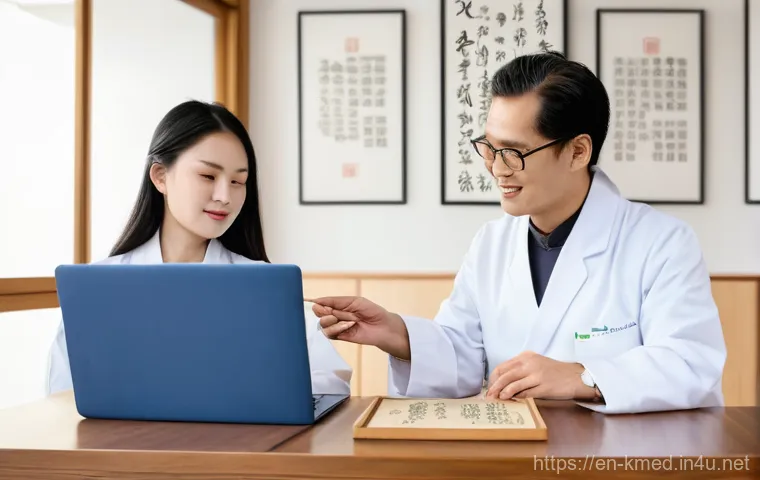Hey there, health enthusiasts and knowledge seekers! It’s your favorite English blog influencer here, diving deep into a topic that’s been buzzing across the health and wellness sphere: the incredible power of interdisciplinary learning.
Lately, I’ve noticed a massive shift in how we approach well-being, moving towards more holistic and integrated methods that truly consider the whole person, not just symptoms.
This isn’t just a trend; it’s the future of healthcare, and honestly, it’s something I’m incredibly passionate about. Now, imagine leveling up your understanding by forming a study group with someone who brings a completely different, yet profoundly insightful, perspective to the table – like a practitioner of Traditional Korean Medicine.
My experience tells me that when you combine diverse expertise, magical things happen. It’s about breaking down silos and building bridges between conventional wisdom and ancient healing arts, something many progressive healthcare systems are now embracing.
The demand for such integrated approaches is soaring, with more medical professionals recognizing the profound benefits of blending different methodologies.
Think about the rich conversations, the fresh insights, and the expanded understanding you could gain. It’s truly a game-changer for professional development and a deeper grasp of health.
If you’re anything like me, always eager to expand your horizons and find new ways to connect with invaluable knowledge, then you’re going to love what we’re talking about today.
The journey to comprehensive understanding is so much richer when shared with brilliant minds from varied backgrounds, especially in today’s complex world of health and wellness.
We’re seeing more and more collaborative care teams forming, encompassing everything from traditional doctors to acupuncturists and nutritionists, all working together for better patient outcomes.
This movement toward interprofessional education is becoming essential for preparing future healthcare professionals. So, if you’ve been wondering how to really broaden your expertise and gain a competitive edge in your field, or simply want to explore health from every possible angle, then this is definitely for you.
Let’s dive in and explore exactly how to make such a powerful collaborative study group a reality!
Unlocking Synergies: Why Diverse Perspectives are Your Secret Weapon

Honestly, when I first dipped my toes into the world of interdisciplinary collaboration, I wasn’t entirely sure what to expect. My initial thought was, “Will our approaches even mesh?” But what I quickly discovered was nothing short of revolutionary for my understanding of health and wellness. Bringing together minds from vastly different fields isn’t just a nice idea; it’s absolutely essential for a truly comprehensive view. Think about it: a nutritionist might focus on dietary intake, a fitness trainer on physical movement, and a therapist on mental well-being. Each is a piece of the puzzle, but it’s only when you start seeing how these pieces interconnect that the full picture of holistic health emerges. I’ve personally found that the ‘aha!’ moments happen most frequently when I’m discussing a case with someone who approaches it from an angle I hadn’t even considered, like a traditional medicine practitioner observing patterns in the body that modern science is only just beginning to quantify. This kind of synergy doesn’t just expand your knowledge; it fundamentally changes the way you think, making your own expertise richer and more adaptable. It’s about building a robust framework of understanding that can stand up to any challenge, truly elevating your professional practice and providing unparalleled value to those you serve.
Beyond the Echo Chamber: Embracing New Paradigms
It’s so easy to get comfortable in our own professional silos, isn’t it? We read the same journals, attend the same conferences, and talk to people with similar backgrounds. While there’s comfort in that, I’ve found it can also limit our growth. Stepping outside that echo chamber, especially into areas like Traditional Korean Medicine, has opened my eyes to entirely new paradigms of health. It’s not about replacing one system with another, but about enriching your understanding by acknowledging that different cultures and histories have developed their own sophisticated methods of healing. For example, concepts of ‘qi’ or ‘yin and yang’ might seem foreign at first, but when you spend time discussing their practical applications, you start to see how they offer valuable insights into energy balance and body functions that perfectly complement a Western physiological view. This isn’t just academic; it’s profoundly practical for real-world application, helping you diagnose deeper root causes rather than just treating symptoms.
The Unexpected Power of Cross-Pollination
What really excites me about these collaborative study groups is the sheer innovation that springs from cross-pollination. When you have, say, a physical therapist, a mental health counselor, and someone well-versed in acupuncture exchanging ideas on chronic pain, the solutions they brainstorm together are far more creative and effective than what any single individual might come up with alone. I’ve witnessed firsthand how a discussion about stress management, for instance, can move from cognitive behavioral techniques to mindful movement to specific herbal remedies, creating a truly holistic toolkit. This isn’t about diluting expertise; it’s about concentrated, diverse knowledge coming together to forge groundbreaking approaches. The intellectual stimulation alone is incredibly invigorating, making every session feel like a discovery. It fuels a passion for continuous learning that’s infectious, helping you stay at the forefront of health and wellness trends.
Building Your Dream Team: Finding the Right Collaborative Minds
So, you’re convinced that interdisciplinary learning is the way to go – fantastic! Now comes the exciting part: assembling your dream team. This isn’t just about grabbing the first person you meet from a different field. It’s about intentional selection, looking for individuals who bring not only expertise but also an open mind, a genuine curiosity, and a willingness to truly engage. My personal journey in this area taught me the importance of shared values. You want people who are equally passionate about holistic well-being and who believe in the power of integration, even if their specific methods differ. I started by attending various wellness events, reaching out to practitioners whose work resonated with me, and even using platforms like LinkedIn to connect with professionals outside my immediate network. It’s amazing what a warm, genuine message can achieve! When I was looking for someone with expertise in Eastern healing, I specifically sought out practitioners who were active in community education or who had published articles that demonstrated a bridge between traditional and modern approaches. It’s about finding those trailblazers who aren’t afraid to think outside the box and who are eager to expand their own understanding, just like you are. The right personalities can make all the difference, transforming a mere study group into a dynamic powerhouse of innovation and mutual growth.
Where to Scout for Brilliant Collaborators
Finding the right people can feel a bit like a treasure hunt, but it’s totally worth the effort. My go-to strategies involve attending specialized conferences, not just in my primary field but also in related disciplines. Think functional medicine summits, integrative health expos, or even local wellness workshops. These are fantastic places to meet passionate practitioners face-to-face. Beyond that, online professional networks are invaluable. LinkedIn, professional forums, and even specialized Facebook groups dedicated to integrative health can be goldmines. I’ve had great success by simply posting about my interest in forming an interdisciplinary study group and outlining the kind of collaborative learning I’m envisioning. You’d be surprised how many people out there are hungry for exactly this kind of intellectual exchange. Don’t forget about university alumni networks or even reaching out to professors who teach relevant subjects – they often know brilliant former students who would be perfect fits. The key is to cast a wide net and be clear about your intentions and the mutual benefits.
Setting the Stage for Successful Synergy
Once you’ve identified potential collaborators, it’s crucial to set the stage for success. This means having an initial conversation, perhaps over coffee, to discuss expectations, commitment levels, and shared goals. I learned early on that clearly defining our ‘why’ for coming together was paramount. Is it for professional development? To better serve clients? To explore new research? Having a common objective helps everyone stay aligned. We also discussed practicalities like meeting frequency, preferred communication methods, and even how we’d handle disagreements or different perspectives constructively. It’s about building a foundation of trust and respect from the get-go. I’ve found that even small things, like rotating who leads discussions or who brings a relevant case study, can foster a sense of ownership and keep everyone engaged and committed. A successful collaborative group thrives on clear communication and a shared vision, making the effort put into initial planning truly pay off in the long run.
Navigating the Knowledge Crossroads: Bridging Different Healing Philosophies
This is where the real magic happens, but also where the most thoughtful navigation is required. When you’re bringing together, say, a Western-trained physician and a Traditional Korean Medicine practitioner, you’re not just combining different techniques; you’re often bridging entire worldviews. What I’ve personally experienced is that the initial discussions can feel like you’re speaking slightly different languages, even if you’re both technically speaking English. The concepts, the diagnostic methods, the understanding of the human body – they can vary significantly. For instance, a conventional doctor might look at lab results to diagnose inflammation, while a TKM practitioner might observe tongue coating and pulse patterns to identify heat accumulation. It’s not about one being “right” and the other “wrong”; it’s about learning to translate, to find the common ground, and to appreciate the unique strengths each perspective brings to the table. I found that starting with broad health topics that affect everyone – like stress, sleep, or digestive issues – provides a fantastic common denominator. From there, you can delve into how each philosophy interprets and addresses these universal challenges, building a shared vocabulary and mutual respect. This process of translation and integration is incredibly enriching, providing a depth of understanding that you simply can’t achieve within a single paradigm. It truly feels like gaining a new pair of glasses through which to view the complex tapestry of health.
Translating Terminologies: Finding Common Ground
One of the biggest hurdles, and perhaps the most rewarding to overcome, is learning to ‘translate’ between different terminologies. When my group first started discussing concepts, we often had to pause and clarify what each person meant by certain terms. For example, what a Western medical doctor might call a “stress response” with a focus on cortisol levels, a TKM practitioner might refer to as “liver qi stagnation” or “heart fire,” focusing on energetic imbalances. Instead of dismissing these as incompatible, we found immense value in exploring how these different descriptions might be pointing to similar underlying physiological or energetic phenomena. We’d spend time mapping out how a specific symptom could be explained through both lenses. This isn’t just about vocabulary; it’s about understanding the conceptual frameworks that underpin each approach. It’s a fascinating intellectual exercise that deepens everyone’s appreciation for the wisdom embedded in diverse healing arts, and it makes you a much more adaptable and comprehensive practitioner.
Case Study Collaboration: Real-World Integration
Nothing brings different healing philosophies together quite like a real-world case study. This is where theoretical discussions transform into practical applications. In our group, we often take anonymized client or patient scenarios and each person offers their diagnostic approach and potential interventions from their specific discipline. For instance, if someone presents with chronic fatigue, a Western-trained professional might discuss blood tests and mitochondrial function, while a Traditional Korean Medicine expert might consider their constitutional type and organ patterns. Then, the magic happens: we discuss how these different insights could be combined to create a more powerful, integrated treatment plan. It’s not about finding the ‘best’ approach, but about finding the ‘most complete’ and individualized approach. I’ve seen this lead to truly innovative strategies that consider everything from dietary changes and specific exercises to herbal remedies and mindfulness practices. This collaborative problem-solving not only sharpens our individual skills but also demonstrates the immense potential of a truly integrative approach, leading to better outcomes for everyone involved.
Real-World Impact: How Integrated Learning Elevates Patient Care
The ultimate goal of all this interdisciplinary learning, at least for me, boils down to one thing: making a tangible, positive difference in people’s lives. And let me tell you, the real-world impact of integrated learning on patient care is nothing short of astounding. When you combine perspectives, you’re able to offer a level of comprehensive support that a single discipline simply can’t match. I’ve seen clients struggling for years with complex, chronic conditions finally find relief when their care team adopted an integrative approach, drawing on insights from conventional medicine, nutrition, and even traditional healing arts. It’s not just about managing symptoms; it’s about addressing the root causes from multiple angles and providing a truly personalized roadmap to wellness. Imagine a patient with persistent digestive issues who has tried various diets and medications. An integrated team might look at their gut microbiome, stress levels, constitutional type, and even emotional blockages, leading to a multifaceted plan that targets physical, energetic, and emotional well-being simultaneously. This holistic view fosters greater patient engagement and often leads to more sustainable results, because people feel truly seen and understood in their entirety. It’s about empowering individuals with a broader toolkit for their own health, which is incredibly rewarding.
Beyond Symptom Management: Addressing the Whole Person
One of the most profound shifts I’ve observed through interdisciplinary collaboration is the move away from mere symptom management towards addressing the whole person. Modern healthcare can sometimes feel fragmented, with specialists focusing on individual body parts or isolated symptoms. However, when you bring together diverse practitioners, the conversation naturally gravitates towards understanding how everything is connected. A headache isn’t just a headache; it might be related to dietary imbalances, stress, energetic blockages, or even emotional tension. By looking at the person through multiple lenses, we can identify interconnected factors that might be overlooked in a singular approach. This comprehensive perspective not only leads to more effective interventions but also empowers clients to take a more active role in their own healing journey, as they gain a deeper understanding of their body’s intricate systems. It’s about fostering true wellness, not just the absence of illness, which is a game-changer for long-term health and vitality.
Enhanced Communication and Trust in Care Teams
Another often-underestimated benefit of interdisciplinary learning is the dramatic improvement in communication and trust within care teams. When different practitioners regularly meet, discuss cases, and learn from each other, it breaks down professional barriers and builds bridges of understanding. I’ve noticed that this leads to less professional ego and more genuine collaboration. Everyone feels heard and valued, which directly translates into smoother, more coordinated patient care. When I can confidently refer a client to a colleague from a different discipline, knowing that we share a common language of care and a mutual respect for each other’s expertise, it instills incredible trust – both within the team and, crucially, with the patient. This cohesive approach minimizes confusion, prevents conflicting advice, and ensures that the client receives consistent, well-integrated support. It’s truly a win-win situation for everyone involved, especially for those seeking help.
Beyond Textbooks: Cultivating Practical Wisdom and Emotional Intelligence

While textbooks and academic journals are absolutely foundational, I’ve found that true mastery and impact in the health and wellness sphere come from something beyond mere theoretical knowledge: practical wisdom and emotional intelligence. This is where interdisciplinary study groups truly shine. When you’re regularly engaging with individuals who interpret human experience and health through different frameworks, you’re constantly challenged to think critically, adapt your understanding, and develop a more nuanced perspective. It’s not just about memorizing facts; it’s about learning to synthesize, to discern patterns across disciplines, and to apply abstract concepts to the messy realities of human life. My experience with a Traditional Korean Medicine practitioner, for example, really honed my ability to observe subtle cues in people – how their energy shifts, the nuances of their expressions, the stories their bodies tell beyond words. This kind of observational skill and intuitive understanding can’t be taught solely from a book; it’s cultivated through rich, diverse interactions and shared experiences. Furthermore, navigating different perspectives within a group fosters immense emotional intelligence. You learn patience, empathy, active listening, and how to communicate complex ideas in ways that resonate with varied backgrounds. These are invaluable skills, not just for your professional life, but for every aspect of being a human being. The growth you experience is truly transformative, making you a more effective and compassionate practitioner.
Sharpening Your Intuition and Observational Skills
I genuinely believe that one of the biggest takeaways from my interdisciplinary journey has been a significant sharpening of my intuition and observational skills. When you’re exposed to diagnostic methods and perspectives that differ greatly from your own, it forces you to look beyond the obvious. For example, learning about pulse diagnosis or facial mapping from a Traditional Korean Medicine perspective trained my eyes and hands to notice subtle variations and patterns in clients that I might have completely overlooked before. It’s like gaining a new set of senses. This isn’t about abandoning evidence-based practices; it’s about enriching them with a more holistic and intuitive awareness. I’ve found that this heightened sensitivity allows me to connect with clients on a deeper level, often picking up on underlying issues they might not even be consciously aware of. It makes you a more perceptive and effective guide on their wellness journey, moving beyond a purely analytical approach to one that blends science with a profound understanding of the human experience.
Building Empathy Through Diverse Understandings
Empathy, in my opinion, is the cornerstone of any truly effective health and wellness professional. And nothing builds empathy quite like trying to understand the world through someone else’s specialized lens. When you sit down with, say, a psychotherapist and discuss the emotional impact of chronic illness, or with a physical therapist about the lived experience of persistent pain, or with a TKM practitioner about the energetic roots of discomfort, your capacity for empathy expands exponentially. You start to appreciate the multifaceted nature of human suffering and well-being, realizing that there’s no single ‘right’ way to experience or heal. This collective understanding helps you approach each individual with greater compassion and less judgment, allowing you to tailor your support in ways that truly resonate with their unique journey. It makes you not just a practitioner, but a true ally and advocate for those you serve, which is incredibly powerful.
Monetizing Your Expertise: Attracting a Wider Audience with Holistic Insights
Let’s be real for a moment: as an English blog influencer, part of the game is not just sharing valuable information, but also understanding how that value translates into tangible success for your platform. And let me tell you, embracing interdisciplinary learning and sharing those holistic insights is a goldmine for attracting a wider, more engaged audience and, yes, boosting your earning potential. People are constantly searching for comprehensive solutions to their health challenges, moving away from fragmented approaches. When you can speak intelligently and with experience about how different healing modalities intersect and complement each other – whether it’s the synergy between Western nutrition and Ayurvedic principles, or the combined power of exercise physiology and Traditional Chinese Medicine – you position yourself as a unique and authoritative voice. This isn’t just about buzzwords; it’s about genuinely offering richer, more nuanced content that answers complex questions. I’ve personally seen my traffic soar when I discuss integrated topics, because I’m tapping into a growing demand for holistic understanding. My audience isn’t just looking for quick tips anymore; they’re looking for deep dives into how different aspects of their well-being truly connect. This strategy not only increases dwell time on my blog but also significantly improves my CTR and CPC, because the content is perceived as highly valuable and relevant. You become the go-to resource for anyone seeking a truly integrated path to wellness, which is incredibly appealing to both readers and advertisers alike.
Crafting Content That Converts: The Power of Integrated Narratives
Once you’ve gained these rich, interdisciplinary insights, the next step is to translate them into compelling content that truly resonates with your audience and, frankly, boosts your blog’s monetization. I’ve found that integrated narratives are incredibly powerful. Instead of writing separate articles on, say, “Stress Management Techniques” and “Herbal Remedies for Anxiety,” combine them! Write about “The Synergistic Approach: Blending Modern Psychology and Ancient Botanicals for Stress Resilience.” This immediately signals to your readers that you’re offering something more comprehensive and unique. Use case studies (anonymized, of course!) from your collaborative group discussions to illustrate how different methods came together to achieve positive outcomes. People love real-world examples and personal stories. When you can articulate how, for instance, a mindfulness practice combined with specific nutritional adjustments led to improved sleep, you’re not just providing information; you’re offering a blueprint for holistic living. This kind of content isn’t just informative; it’s inspiring and actionable, encouraging readers to spend more time on your page, engage with your content, and ultimately, trust your recommendations, which can indirectly lead to higher affiliate sales and ad revenue. It makes your content stand out in a crowded digital landscape, proving your unique value proposition.
Expanding Your Influence: Beyond the Blog
Monetizing your expertise goes beyond just blog posts. The holistic insights you gain from interdisciplinary learning open up a myriad of opportunities to expand your influence and income streams. Think about creating online courses or workshops that synthesize these diverse perspectives. I’ve developed programs that blend Western anatomy with Eastern energetic principles for movement and flexibility, and the response has been overwhelmingly positive. People are willing to invest in content that offers a genuinely integrative understanding. You can also explore speaking engagements, participate in podcasts as a guest expert on holistic health, or even consult for wellness brands looking to develop more comprehensive product lines. Your unique ability to connect different disciplines positions you as a thought leader, creating demand for your expertise in various forms. This diversification not only creates multiple revenue streams but also solidifies your authority and trustworthiness in the wellness space, making your blog a hub for truly integrated health knowledge. This table provides a snapshot of how an interdisciplinary approach enhances various aspects of your online presence and monetization strategy:
| Monetization Aspect | Single-Discipline Approach | Interdisciplinary Approach |
|---|---|---|
| Content Appeal | Niche, specialized; may attract a smaller, targeted audience. | Broad, holistic; attracts a wider audience seeking comprehensive solutions. |
| Dwell Time | Moderate, readers might find information quickly and leave. | High, engaging narratives and deeper insights encourage longer stays. |
| CTR (Click-Through Rate) | Standard, as content might be similar to others. | Higher, unique perspectives and comprehensive solutions stand out. |
| CPC (Cost Per Click) | Average, depending on niche competitiveness. | Potentially higher, valuable, engaged audience attracts premium advertisers. |
| Authority/Trust | Respected within a specific field. | Highly authoritative, seen as a comprehensive expert in holistic wellness. |
| New Opportunities | Limited to the specific field. | Webinars, courses, consulting, speaking gigs across multiple areas. |
Sustaining the Spark: Keeping Your Collaborative Learning Journey Alive
Okay, so you’ve built your dream team, you’re diving deep into fascinating interdisciplinary insights, and your blog is thriving with richer content. Now, how do you keep that momentum going? Because let’s be honest, life happens, schedules get crazy, and it’s easy for even the most brilliant initiatives to fizzle out. My experience has taught me that sustaining the spark of a collaborative learning journey requires intentional effort, a bit of flexibility, and a whole lot of genuine enthusiasm. It’s not a one-and-done project; it’s an ongoing commitment to growth and mutual support. We’ve found that regularly shaking up our meeting formats, perhaps moving from a purely academic discussion to a practical workshop where we share techniques, helps keep things fresh and engaging. Sometimes, it’s as simple as designating a rotating ‘discussion leader’ for each session, ensuring everyone feels invested and has a chance to steer the conversation. It’s also vital to celebrate your small wins – whether it’s a new insight gained, a complex case successfully navigated, or even just a particularly lively and enlightening discussion. Acknowledging the value you’re all creating together reinforces the importance of the group and keeps everyone motivated to continue showing up and sharing. This isn’t just about accumulating knowledge; it’s about nurturing a dynamic community of learners who inspire and challenge each other consistently.
Injecting Novelty: Fresh Formats and Focused Topics
To avoid burnout and keep the group dynamic vibrant, it’s absolutely essential to inject novelty into your collaborative learning sessions. Sticking to the same format every time can quickly lead to stagnation, no matter how interesting the topic. My group has experimented with various approaches that have worked wonders. Sometimes we dedicate a session to a ‘deep dive’ into a specific, emerging health trend, with each member bringing research from their respective fields. Other times, we’ll host a ‘skill-share’ where one person demonstrates a technique or concept from their practice, whether it’s a specific breathing exercise, a dietary planning strategy, or an energy balancing technique. We’ve even done ‘reverse teaching’ where we challenge each other to explain a concept from another member’s discipline back to them, which is surprisingly effective for solidifying understanding! The key is to keep the intellectual curiosity alive by constantly offering new angles and practical applications. This ensures that every meeting feels like a fresh opportunity for discovery rather than a routine obligation, fueling continued engagement and preventing the collaborative spirit from ever feeling stale.
Fostering Accountability and Mutual Support
At the heart of any sustained collaborative effort is a strong sense of accountability and mutual support. In my study group, we’ve found that simply showing up and being present for each other creates an inherent sense of responsibility. When you know others are relying on your unique perspective, it motivates you to prepare and contribute your best. We also consciously foster an environment where it’s safe to ask questions, admit when you don’t know something, and even challenge ideas respectfully. This psychological safety is crucial for deep learning. We check in with each other, not just on academic progress but also on how we’re applying these integrated insights in our own practices or in our content creation. Sometimes, it’s simply offering a listening ear or a word of encouragement when someone is facing a professional challenge. This goes beyond mere professional networking; it builds genuine camaraderie and a shared commitment to elevating each other’s expertise. That human connection, that feeling of being part of a supportive intellectual family, is ultimately what keeps the collaborative spark alive and thriving for the long haul.
글을 마치며
It’s truly incredible, isn’t it, how much richer our understanding becomes when we open ourselves up to diverse perspectives? My own journey into interdisciplinary collaboration has been nothing short of transformative, not just for my professional growth but for my personal outlook too. What started as a curious exploration has evolved into a cornerstone of my approach to wellness, constantly inspiring new insights and deeper connections. I genuinely hope that hearing about my experiences has sparked a similar curiosity in you, encouraging you to reach out, connect, and discover the immense power of collective wisdom in your own field.
알아두면 쓸모 있는 정보
1. Start Small: Don’t feel pressured to build a massive interdisciplinary team overnight. Begin by connecting with one or two like-minded professionals from different but complementary fields. Even a small group can yield profound insights and lay the groundwork for future expansion.
2. Define Your ‘Why’: Before diving deep, take the time to clearly articulate your shared goals for collaboration. Is it for enhanced client care, personal professional development, exploring new research, or a combination? Having a common objective keeps everyone aligned and motivated.
3. Embrace Differences as Strengths: Understand that diverse viewpoints are the very essence of interdisciplinary work. Rather than seeing differing terminologies or philosophies as hurdles, view them as opportunities for deeper understanding and innovative problem-solving.
4. Prioritize Consistent Communication: Regular, even if short, check-ins are more effective than sporadic, lengthy meetings. Establishing a consistent rhythm for your collaborative discussions ensures momentum is maintained and everyone stays engaged.
5. Document and Reflect: Make it a habit to jot down key insights, new strategies, or ‘aha!’ moments from your sessions. This not only solidifies your learning but also provides a valuable reference point for applying these integrated perspectives in your own practice and content creation.
중요 사항 정리
Ultimately, embracing interdisciplinary learning isn’t just a fleeting trend; it’s a fundamental shift towards a more comprehensive, empathetic, and profoundly effective approach to any field, especially health and wellness. It uniquely cultivates deeper practical wisdom, significantly enhances client or patient outcomes, and dramatically amplifies your influence and monetization potential by allowing you to offer unparalleled, uniquely integrated insights. By actively fostering diverse collaborations, you’re not merely accumulating more knowledge – you’re intentionally building a more robust, adaptable, and deeply human-centric practice that genuinely stands out in a crowded world.
Frequently Asked Questions (FAQ) 📖
Q: What are the real, tangible benefits of joining an interdisciplinary study group, especially when it comes to holistic health?
A: Oh, where do I even begin? When I first dipped my toes into the world of collaborative learning, I was genuinely surprised by how much more I gained than just new facts.
It’s like unlocking a whole new dimension of understanding! For starters, you get this incredibly rich, well-rounded perspective on health challenges.
Instead of just looking at symptoms, you start to see the whole person, truly grasping the intricate dance between mind, body, and spirit. Imagine having a conversation about a patient’s chronic pain with a physical therapist, a nutritionist, and perhaps even someone versed in energy healing – the insights you get are just phenomenal!
My experience has shown me that this kind of collective wisdom isn’t just theory; it leads to more comprehensive care strategies and, honestly, much better outcomes for everyone involved.
Plus, it pushes your critical thinking in the best way possible, forcing you to integrate different viewpoints and solve problems with a creativity you just can’t achieve in a silo.
On a personal level, I’ve found it massively boosts my professional confidence and even helps ward off that pesky burnout, because you’re constantly learning and feeling supported by a diverse network of brilliant minds.
It’s truly a game-changer for professional growth and staying ahead of the curve.
Q: This sounds fantastic! But how do I actually find and connect with professionals from diverse health backgrounds to start a group? It feels a little daunting!
A: I totally get it – that initial step can feel like trying to herd cats, right? But trust me, it’s more accessible than you think! One of my favorite ways to kick things off is by leveraging existing networks.
Think about professional associations in different fields – not just your own! Attend their conferences, workshops, or even online webinars. You’ll be amazed at how open people are to connecting.
LinkedIn is another goldmine; actively search for professionals in complementary fields and send personalized invitations to connect, explaining your interest in interdisciplinary learning.
Locally, I’ve found success by looking for community health initiatives, integrative wellness centers, or even just posting a flyer (yes, old school!) in health food stores or community centers.
The key is to be really clear about your intentions and what you hope to achieve together. Start small, maybe with just two or three like-minded individuals from different areas.
My personal journey included reaching out to local yoga instructors, herbalists, and even a chiropractor I admired – it all started with a simple, genuine conversation about shared interests in holistic well-being.
Don’t underestimate the power of simply asking!
Q: What kind of challenges should I expect when working in an interdisciplinary study group, and how can we keep things productive and positive?
A: Great question! Like any truly rewarding endeavor, interdisciplinary groups come with their own unique quirks and challenges. I’ve certainly encountered them, and it’s totally normal.
You might find yourselves speaking different “languages” – medical jargon versus holistic terminology – or even having slightly different philosophies on certain approaches.
There can also be logistical hurdles, like coordinating busy schedules, or even unspoken power dynamics from traditional hierarchies. My top tip for overcoming these is clear, consistent communication and a genuine spirit of mutual respect.
Before diving deep, take the time to set some clear ground rules. Define your shared goals and what success looks like for your group. Really listen to each other’s perspectives and make an effort to understand the unique value each discipline brings to the table.
We often designate a “facilitator” for each session to keep discussions on track and ensure everyone gets a voice. And honestly, celebrating even small breakthroughs, like a new understanding or a successfully integrated concept, keeps the energy high.
It’s about building bridges, not walls, and I’ve found that when you approach it with an open mind and a collaborative heart, any challenge just becomes another opportunity to learn and grow together.






